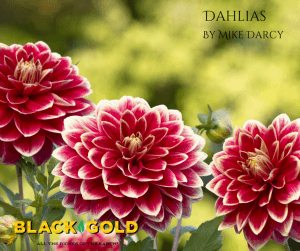
As of September 22, we have officially moved into the autumn season. I don’t think that plants know it is autumn, nor that they care, but we humans do know and care. Here in the Pacific Northwest, it has been a very unpredictable spring and summer season, and autumn looks to be just as unpredictable. We have experienced some very high temperatures for this time of year and taking a snapshot of many plants in pots on my deck, it resembles a summer scene. Impatiens, coleus, zinnias, salvia, cannas, are just a few that are still providing lots of color.
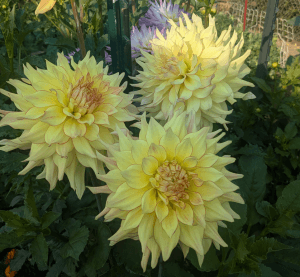
This photo shows the first flush of blooms on the dahlia Hart’s Bonnie and it’s classified as a B size (medium) ID (informal decorative) Yellow. The unique thing about this variety is the fine line of red found on the margin of the ray florets. This is called picotee and is quite rare.
However, the standout flowers now are the dahlias. The late summer and early fall is their time to shine and they are certainly giving us a grand performance, Dahlias have become a mainstream plant in many gardens and it appears that they are ‘growing’ in popularity. Visiting other gardens and walking in my neighborhood, there is little doubt that dahlias reign at this season. The Pacific Northwest appears to be an ideal climate for them, and I am continually amazed at the diversity of the flower shapes and sizes, and the wide diversity of colors.

Just in time for Halloween is ‘Bloomquist Jean’ a medium size, the form is informal decorative, and, of course, it’s orange.
Dahlias originated from Mexico and Guatemala and in 1651 reports of flowers that were bigger than asters were published in Rome. These reports originated from Spaniards living in Mexico and while the American Dahlia Society was established in 1913, dahlias had been popular in Europe for probably one hundred years earlier.
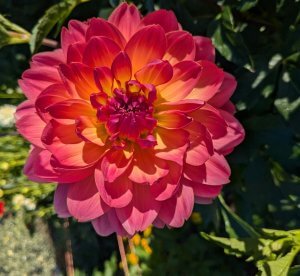
Ken’s Rarity, a waterlily type dahlia
While dahlias can be grown from seed, most home gardeners start them from tubers that are widely available in garden centers in the spring. Dahlias are a warm, season flower and should not be planted outdoors until all danger of frost is over. Many gardeners will plant tubers indoors about a month before they can be transplanted outdoors, and Black Gold® Natural & Organic Seedling Mix is an ideal medium for starting the tubers. Starting them indoors will give the plants a head start and plants will usually bloom earlier than those tubers planted outdoors later in the season.

Dahlia ‘Star Child’
Dahlias like plenty of organic matter such as Black Gold® Natural & Organic Garden Compost Blend worked into the soil prior to planting. Good drainage is essential and if poor drainage is an issue, the addition of Black Gold® Perlite may be a benefit. Dahlias thrive in a full sun location. The tall growing types have a tendency to be floppy and I like to put in a wooden garden stake next to the tuber at time to planting to use as support during the growing season.
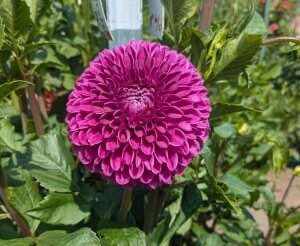
‘Narrow’s Kirsten’, a ball, dark pink
As the autumn season wanes and the leaves begin to turn yellow or there is a frost and the leaves die, cut the stems back to ground level. Dahlia stems are hollow and if water gets in the stems and freezes, the tubers will be damaged and may die. There are a couple of choices here on what to do next. Once plants have been cut to ground level, some gardeners will carefully lift the tubers out of the ground and store them in a container in a frost-free area such as a garage. Black Gold® Perlite is excellent to use around the tuber to protect from cold temperatures.
Another storage method is to leave the tubers in the ground. With this method, the hollow stems should be cut to where they attach to the tuber and is solid, not hollow. Then apply a thick layer of mulch over the tubers. If the winter is severe, this may not offer enough protection and thus the lifting and storing the tuber is a more reliable method.
I have a neighbor that is a big dahlia grower. He has a large bed and did not want to lift all the tubers, and he had no good place to store them. After the first frost, he cut the stems down to the tuber and put a plastic tarp over the entire dahlia bed. On top of the tarp, he added a 4–6-inch layer of leaves and compost. Even though we had some severe winter weather, his dahlias all survived.
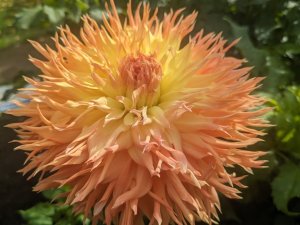
This is Maggie C. a medium sized bloom of light blend of yellow and orange.”Lacinate” refers to a characteristic in which the tips of ray florets are split or divided, creating a fringed or feathery appearance
This is the time to take notes on what are some of your favorites and then order tubers for spring delivery. For specific color and color combinations, I have learned that, if possible, actually view the dahlia rather than relying on a photo. This way, you are assured of getting the flower that you want.
Dahlias also make great container plants, especially the small and medium size growing types. They will provide a long season of bloom, usually mid-July until the first frost. They also make excellent cut flowers. If you have not grown them, give them a try in the spring.
Note: All photos and captions are by Portland Dahlia Society lifetime member Gary Murphy.

